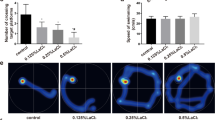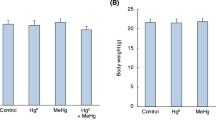Abstract
We evaluated the role of βIII-tubulin in the morphology of olfactory receptor neuron (ORN) and olfactory dysfunction in offspring caused by prenatal and postnatal lanthanum exposure. Pregnant rats were exposed to 0.25% lanthanum chloride in drinking water from gestational day (GD) 7 until postnatal day 21. From postnatal day 23 until postnatal day 28, pups were examined with buried food pellet and olfactory maze test. The ultrastructural features of ORNs in the olfactory epithelium (OE) were observed by transmission electron microscope. The expression of βIII-tubulin and olfactory marker protein (OMP) in the tissue sections and homogenates of OE were, respectively, measured by immunodetection and western blot. Behavioral analysis of olfaction showed that lanthanum chloride exposure induced olfactory dysfunction. Offsprings exposed to lanthanum chloride showed enlarged ORN knobs and a decreased number of cilia. In addition, the levels of OMP and βIII-tubulin expression in lanthanum chloride exposure offsprings significantly decreased. Developmental lanthanum exposure could impair olfaction, and this deficit may be attributed to the downregulation of βIII-tubulin and OMP in the OE.





Similar content being viewed by others
References
Yang J, Liu Q, Zhang L, Wu S, Qi M, Lu S, Xi Q, Cai Y (2009) Lanthanum chloride impairs memory, decreases pCaMK IV, pMAPK and pCREB expression of hippocampus in rats. Toxicol Lett 190:208–214
Zhao H, Cheng Z, Hu R, Chen J, Hong M, Zhou M, Gong X, Wang L, Hong F (2011) Oxidative injury in the brain of mice caused by lanthanid. Biol Trace Elem Res 142:174–189
Zha H, Cheng Z, Chen J, Hu R, Che Y, Cui Y, Wang L, Hong F (2011) The toxicological effects in brain of mice following exposure to cerium chloride. Biol Trace Elem Res 144:872–884
Zhu W, Xu S, Shao P, Zhang H, Wu D, Yang W, Feng J (1997) Bioelectrical activity of the central nervous system among populations in a rare earth element area. Biol Trace Elem Res 57:71–77
Summers MJ, Crowe SF, Ng KT (1996) Administration of lanthanum chloride following a reminder induces a transient loss of memory retrieval in day-old chicks. Brain Res Cogn Brain Res 4:109–119
Briner W, Rycek RF, Moellenberndt A, Dannull K (2000) Neurodevelopmental effects of lanthanum in mice. Neurotoxicol Teratol 22:573–581
Feng LX, Xiao HQ, He X, Li ZJ, Li FL, Liu NQ, Chai ZF, Zhao YL, Zhang ZY (2006) Long-term effects of lanthanum intake on the neurobehavioral development of the rat. Neurotoxicol Teratol 28:119–124
Alexy T, Nemeth N, Wenby RB, Bauersachs RM, Baskurt OK, Meiselman HJ (2007) Effect of lanthanum on red blood cell deformability. Biorheology 44:361–373
Feng LX, Xiao HQ, He X, Li ZJ, Li FL, Liu NQ, Zhao YL, Huang YY, Zhang ZY, Chai ZF (2006) Neurotoxicological consequence of long-term exposure to lanthanum. Toxicol Lett 165:112–120
He X, Zhang Z, Zhang H, Zhao Y, Chai Z (2008) Neurotoxicological evaluation of long-term lanthanum chloride exposure in rats. Toxicol Sci 103:354–361
Lancet D, Sadovsky E, Seidemann E (1993) Probability model for molecular recognition in biological receptor repertoires: significance to the olfactory system. Proc Natl Acad Sci U S A 90:3715–3719
Lu DC, Zhang H, Zador Z, Verkman AS (2008) Impaired olfaction in mice lacking aquaporin-4 water channels. FASEB J 22:3216–3223
Buck LB (2000) The molecular architecture of odor and pheromone sensing in mammals. Cell 100:611–618
Carr VM, Farbman AI, Colletti LM, Morgan JI (1991) Identification of a new non-neuronal cell type in rat olfactory epithelium. Neuroscience 45:433–449
Wrobel BB, Leopold DA (2005) Olfactory and sensory attributes of the nose. Otolaryngol Clin North Am 38:1163–1170
Mackay-Sim A, Kittel PW (1990) On the life span of olfactory receptor neurons. Eur J Neurosci 3:209–215
Katsetos CD, Legido A, Perentes E, Mörk SJ (2003) Class III beta-tubulin isotype: a key cytoskeletal protein at the crossroads of developmental neurobiology and tumor neuropathology. J Child Neurol 18:851–866
Jouhilahti EM, Peltonen S, Peltonen J (2008) Class III beta-tubulin is a component of the mitotic spindle in multiple cell types. J Histochem Cytochem 56:1113–1119
Roskams AJ, Cai X, Ronnett GV (1998) Expression of neuron-specific beta-III tubulin during olfactory neurogenesis in the embryonic and adult rat. Neuroscience 83:191–200
Lee AC, He J, Ma M (2011) Olfactory marker protein is critical for functional maturation of olfactory sensory neurons and development of mother preference. J Neurosci 31:2974–2982
Margolis FL (1972) A brain protein unique to the olfactory bulb. Proc Natl Acad Sci U S A 69:1221–1224
Reeves PG, Nielsen FH, Fahey GC (1993) AIN-93 purified diets for laboratory rodents: final report of the American Institute of Nutrition ad hoc writing committee on the reformulation of the AIN-76A rodent diet. J Nutr 123:1939–1951
Kondo K, Watanabe K, Sakamoto T, Suzukawa K, Nibu K, Kaga K, Yamasoba T (2009) Distribution and severity of spontaneous lesions in the neuroepithelium and Bowman’s glands in mouse olfactory mucosa: age-related progression. Cell Tissue Res 335:489–503
Ji YJ, Cui MZ (1988) Toxicological studies on safety of rare earths used in agriculture. Biomed Environ Sci 1:270–276
D’Agostino RB, Lown BA, Morganti JB, Massaro EJ (1982) Effects of in utero or suckling exposure to cerium (citrate) on the postnatal development of the mouse. J Toxicol Environ Health 10:449–458
Abramczuk JW (1985) The effects of lanthanum chloride on pregnancy in mice and on preimplantation mouse embryos in vitro. Toxicology 34:315–320
Sullivan RM, Wilson DA (2003) Molecular biology of early olfactory memory. Learn Mem 10:1–4
Nathan BP, Yost J, Litherland MT, Struble RG, Switzer PV (2004) Olfactory function in apoE knockout mice. Behav Brain Res 150:1–7
Lee VM, Pixley SK (1994) Age and differentiation-related differences in neuron-specific tubulin immunostaining of olfactory sensory neurons. Brain Res Dev Brain Res 83:209–215
Schwob JE, Mieleszko Szumowski KE, Stasky AA (1992) Olfactory sensory neurons are trophically dependent on the olfactory bulb for their prolonged survival. J Neurosci 12:3896–3919
Farbman AI (1990) Olfactory neurogenesis: genetic or environmental controls? Trends Neurosci 13:362–365
Schwob JE (2002) Neural regeneration and the peripheral olfactory system. Anat Rec 269:33–49
Rodriguez-Gil DJ, Treloar HB, Zhang X, Miller AM, Two A, Iwema C, Firestein SJ, Greer CA (2010) Chromosomal location-dependent nonstochastic onset of odor receptor expression. J Neurosci 30:10067–10075
Acknowledgments
This study was supported by the National Natural Science Foundation of China (30772414 and 30901209).
Author information
Authors and Affiliations
Corresponding author
Rights and permissions
About this article
Cite this article
Hao, S., Yu, F., Yan, A. et al. In Utero and Lactational Lanthanum Exposure Induces Olfactory Dysfunction Associated with Downregulation of βIII-tubulin and Olfactory Marker Protein in Young Rats. Biol Trace Elem Res 148, 383–391 (2012). https://doi.org/10.1007/s12011-012-9386-9
Received:
Accepted:
Published:
Issue Date:
DOI: https://doi.org/10.1007/s12011-012-9386-9




